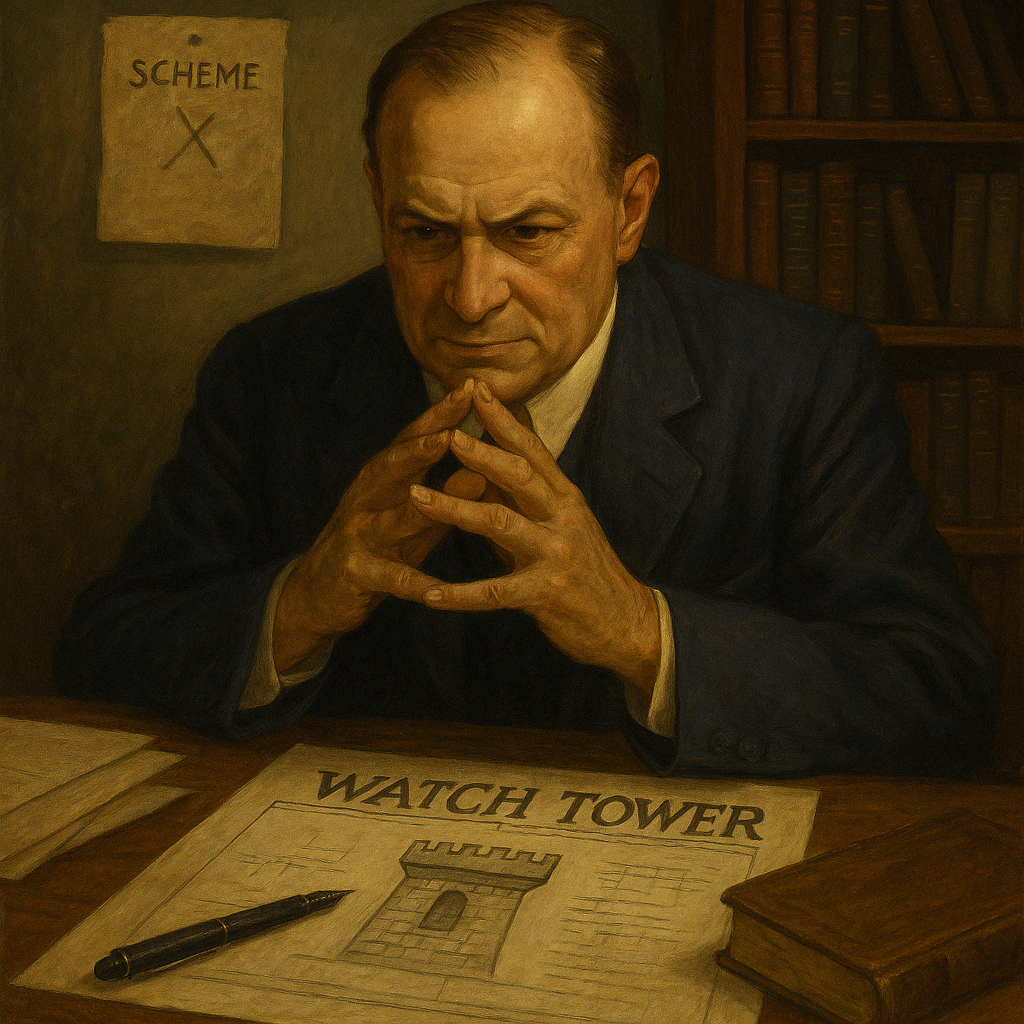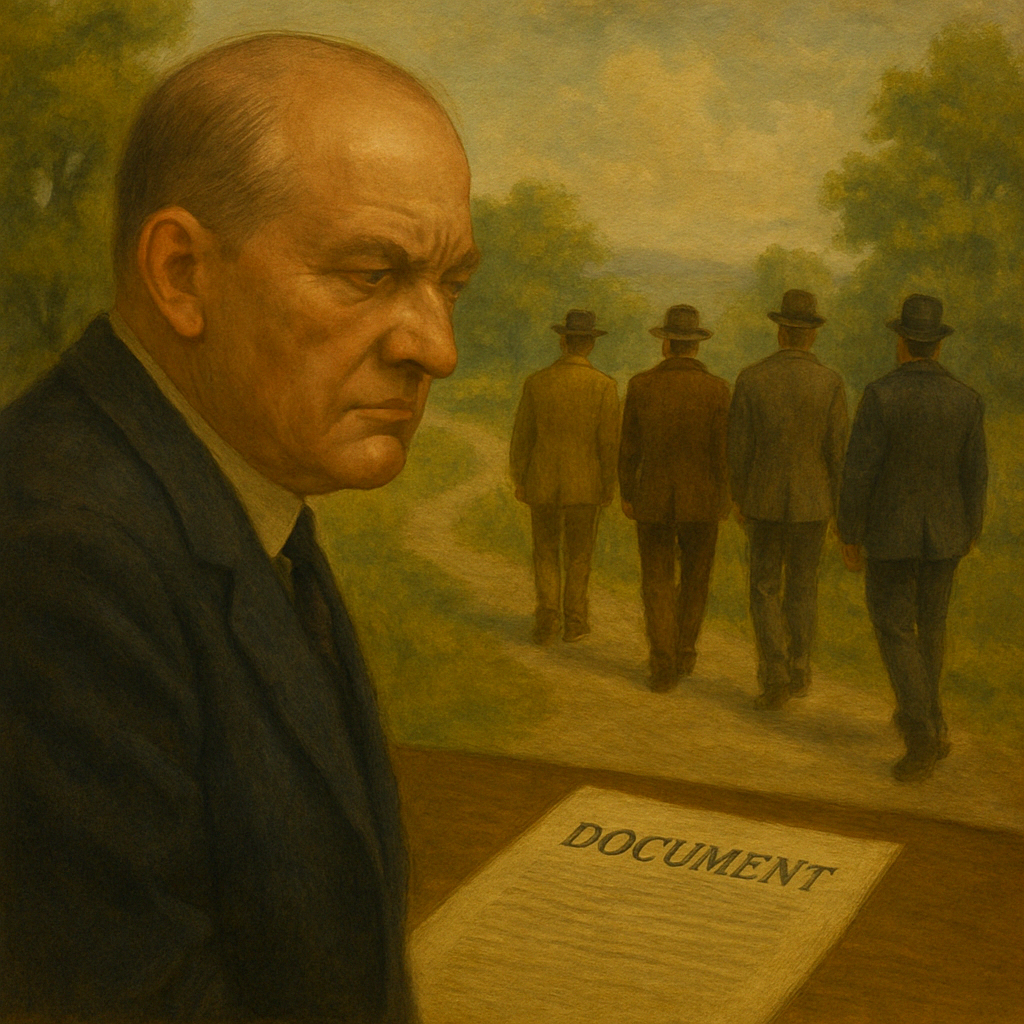The Power Struggle After Russell’s Death
When Charles Taze Russell died on October 31, 1916, he left behind a loosely organized but growing movement of Bible Students, with an estimated 50,000 to 75,000 adherents worldwide.¹ Though he had firmly resisted hierarchical church structures during his life, he had appointed an editorial committee in his will to oversee the Watch Tower magazine and discouraged the concentration of power in any one individual.²

However, within weeks of Russell’s death, Joseph Franklin Rutherford, who had served as legal counsel and a director of the Watch Tower Bible and Tract Society, began to maneuver for control. Despite initially being elected president of the Society in January 1917 with a narrow margin, he soon took steps that consolidated authority into his hands — against the decentralized structure Russell had preferred.³
Legal and Organizational Maneuvers
The controversy escalated in mid-1917 when Rutherford unilaterally published a controversial book titled The Finished Mystery, presenting it as Volume 7 of Russell’s Studies in the Scriptures. Many viewed this as a betrayal of Russell’s wishes, since Russell had explicitly stated no such volume should be published posthumously in his name.⁴
When four of the Society’s board members objected, Rutherford claimed they were not legally appointed and replaced them with his own allies — using technicalities in Pennsylvania corporate law. This move was seen by many as a hostile takeover, sparking outrage among a large portion of the Bible Students.⁵
The Resulting Schisms
By 1918–1920, the organization had splintered significantly. Those who opposed Rutherford’s authoritarian leadership style and doctrinal changes withdrew from the Watch Tower Society, forming independent Bible Student groups.⁶ Notable splinter groups include:
- The Pastoral Bible Institute (1918)
- The Laymen’s Home Missionary Movement (founded by Paul S. L. Johnson)
- Dawn Bible Students Association (1932)
- Free Bible Students Association
- Various other autonomous Bible Student fellowships worldwide

These groups continued to follow Russell’s original writings and organizational philosophy, rejecting Rutherford’s changes.
Meanwhile, those who remained under Rutherford’s direction evolved into what became known in 1931 as “Jehovah’s Witnesses,” marking a definitive departure from Russell’s identity and legacy.⁷
| Doctrine / Feature | Charles T. Russell | Pastoral Bible Institute (1918) | Laymen’s Home Missionary Movement | Dawn Bible Students Association (1932) | Free Bible Students Association | Joseph F. Rutherford (JWs) |
| Name of Group | Bible Students | Bible Students | LHMM | Bible Students | Free Bible Students | Jehovah’s Witnesses |
| Leadership Structure | No centralized authority | Committee-led | Paul S. L. Johnson as spiritual leader | Editorial committee | Local congregational autonomy | Centralized under Governing Body |
| View of Russell | Viewed as “faithful and wise servant” | Deep respect, use his writings | Revered, expanded interpretations | Strict adherence to his teachings | Continued reliance on his writings | Eventually distanced from Russell |
| Use of “Volume 7” (The Finished Mystery) | ❌ Not endorsed by Russell | ❌ Rejected | ✅ Accepted Johnson’s own writings | ❌ Rejected | ❌ Rejected | ✅ Promoted by Rutherford in 1917 |
| Trinity | ❌ Rejected | ❌ Rejected | ❌ Rejected | ❌ Rejected | ❌ Rejected | ❌ Rejected |
| Hellfire | ❌ Denied, taught annihilation | ❌ Denied | ❌ Denied | ❌ Denied | ❌ Denied | ❌ Denied |
| Jesus’ Return | ✅ Invisible return in 1874 | ✅ 1874 | ✅ 1874 | ✅ 1874 | ✅ 1874 | ✅ Changed to 1914 |
| Use of Pyramids | ✅ Taught prophetic pyramidology | ✅ Maintained symbolic view | ✅ Initially accepted | ✅ Symbolic use only | ✅ Symbolic reference | ❌ Rejected and later condemned |
| Celebration of Holidays | ✅ Celebrated Christmas & birthdays | ✅ Permitted | ✅ Permitted | ✅ Permitted | ✅ Permitted | ❌ Strictly forbidden |
| Disfellowshipping | ❌ Rare / not emphasized | ❌ Rare | ❌ Rare | ❌ Rare | ❌ Rare | ✅ Mandatory shunning |
| Blood Transfusions | ❓ Not addressed | ✅ Allowed | ✅ Allowed | ✅ Allowed | ✅ Allowed | ❌ Forbidden |
| Military / Government Involvement | Neutral stance | Allowed by conscience | Allowed | Allowed | Allowed | ❌ Strict neutrality |
| View of Organization | Voluntary association | Independent local groups | Central under Johnson | Decentralized | Autonomous congregations | Global unified Organization |
| Adoption of “Jehovah’s Witnesses” | ❌ Never used | ❌ Never used | ❌ Never used | ❌ Never used | ❌ Never used | ✅ Adopted in 1931 |
All four of these Bible Student offshoots are still active today, though most operate on a much smaller scale than Jehovah’s Witnesses. They continue to promote versions of Charles Taze Russell’s teachings and reject the doctrinal and organizational changes made by Joseph Rutherford.
Summary:
- Russell’s original Bible Student movement fractured shortly after his death.
- Most groups rejected Rutherford’s leadership, his publication of The Finished Mystery, and his changes to doctrine and authority structure.
- Only those who stayed under Rutherford’s centralized rule evolved into Jehovah’s Witnesses, adopting new teachings and stricter controls.
- Other Bible Student groups continued to uphold Russell’s teachings, often preserving holiday observance, local autonomy, and doctrinal flexibility.
Next page, we discuss the event of Brother Rutherford’s takeover and the changes that came to the organization.
[ Next Page – History of Joseph F. Rutherford’s Takeover ]
References:
Tony Wills, A People for His Name: A History of Jehovah’s Witnesses and an Evaluation (Lulu Press, 2006), 82–83.
Watch Tower Bible and Tract Society of Pennsylvania, Jehovah’s Witnesses—Proclaimers of God’s Kingdom (Brooklyn, NY: Watchtower Bible and Tract Society, 1993), 64.
M. James Penton, Apocalypse Delayed: The Story of Jehovah’s Witnesses, 3rd ed. (Toronto: University of Toronto Press, 2015), 53–58.
A. H. Macmillan, Faith on the March (Englewood Cliffs, NJ: Prentice-Hall, 1957), 61–66.
Edmond C. Gruss, The Four Presidents of the Watch Tower Society (Xulon Press, 2003), 58–61.
Alan Rogerson, Millions Now Living Will Never Die: A Study of Jehovah’s Witnesses (London: Constable, 1969), 41–44.
Penton, Apocalypse Delayed, 68–70.
